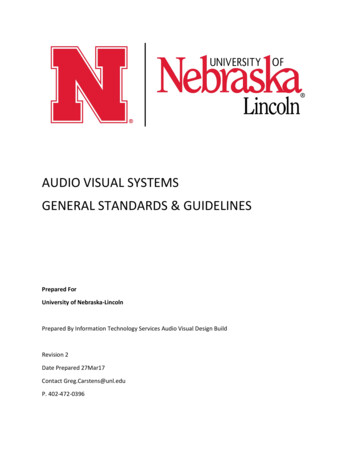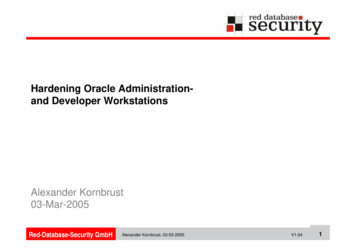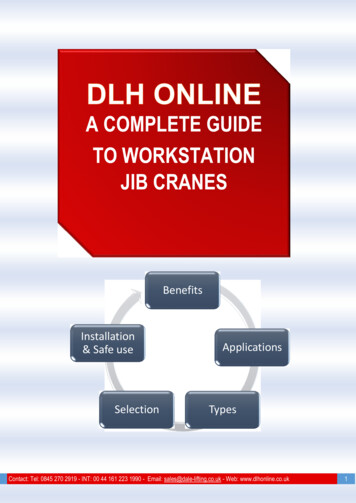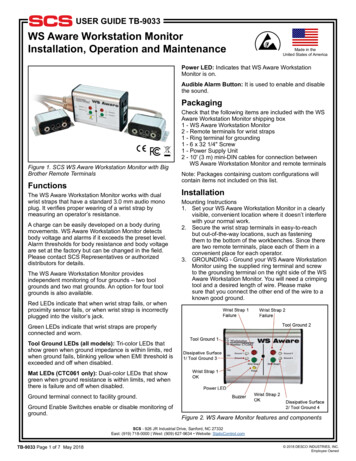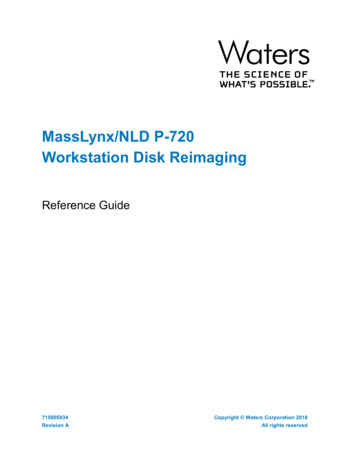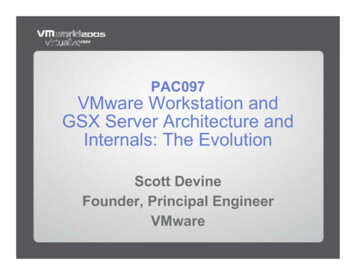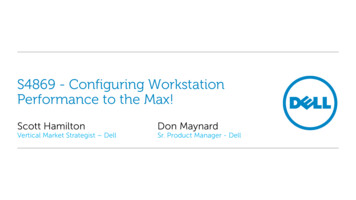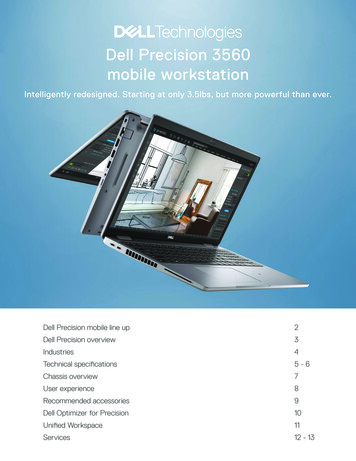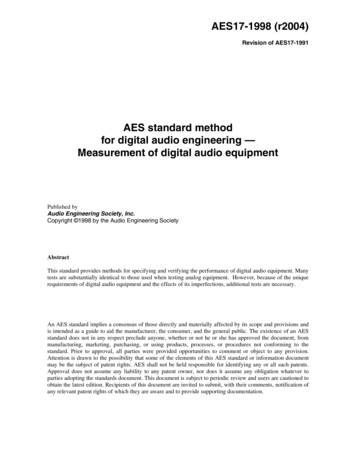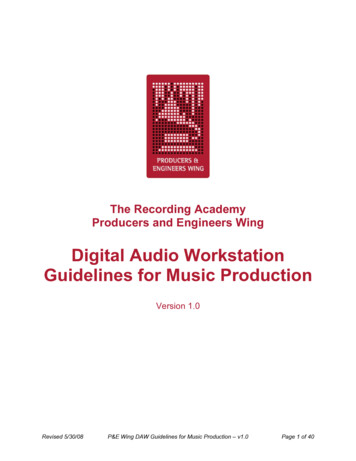
Transcription
The Recording AcademyProducers and Engineers WingDigital Audio WorkstationGuidelines for Music ProductionVersion 1.0Revised 5/30/08P&E Wing DAW Guidelines for Music Production – v1.0Page 1 of 40
A few years ago audio engineers could open a reel of tape they’d never seen before,glance at the track sheet, and begin working almost immediately. Today, with DigitalAudio Workstations (DAWs), replacing tape machines on recording projects, the amountof time between opening a project or session from another engineer and going to workhas definitely increased. And the same can be true when engineers re-open their ownprojects or sessions that they haven't worked on for a few months.Why is this? And why was it so easy in the past? The answer is that over the yearsengineers developed a number of conventions with linear tape and track sheets. Whenthey opened up the tape box they pretty much knew what to expect and, after looking atthe track sheet to confirm a few basics, they could start pulling up the faders.Until now, however, no real conventions of this kind have been established with DAWs.This is what the Digital Audio Workstation Guidelines for Music Production set outto do. When followed, they can greatly improve the process of transferringprojects/sessions between operators, as well as help those operators better organizetheir own projects/sessions.Our committee of very experienced users and manufacturers' representatives ofCubase, Digital Performer, Logic, Nuendo, Pro Tools and Sonar worked for over a yearto create these new guidelines. We based our work on the Pro Tools SessionGuidelines for Music Production created by the Technical Subcommittee of TheRecording Academy Florida Chapter’s Producers & Engineers Wing committee andreleased in 2003. Essentially, these are many of the same Pro Tools guidelines rewritten to apply to all DAWs, along with many updates and new guidelines.To all who invested their time and effort, we’d like to say thank you very much. Yourcontributions are greatly appreciated. It is our hope that these guidelines will helpeveryone as much as they have helped us in improving our productivity when workingwith DAWs.Charles DyeDAW Guidelines for Music Production Committee ChairmanProducers & Engineers Wing of The Recording Academy May 30th, 2008Revised 5/30/08P&E Wing DAW Guidelines for Music Production – v1.0Page 2 of 40
Producers and Engineers WingDAW Guidelines for Music Production CommitteeChuck AinlayCarlos AlvarezJudson CoplanVincent di PasqualeCharles DyeFrank FilipettiTrevor FletcherScott GarrigusGil GowingDon GunnBob HuntJim MorrisTom MorrisRoger NicholsGreg OndoDavid RosenthalEric SchillingRon TaylorSteve ThomasAlex WestnerRevised 5/30/08P&E Wing DAW Guidelines for Music Production – v1.0Page 3 of 40
Table of ContentsCover Letter 2P&E Wing DAW Guidelines Committee . 3Introduction 5Terminology 7Overview of Projects/Sessions . 9Master Project/Session . 10The Basics . 10When Creating A New Project/Session . 11Cleaning Up 13Organization . 14Additional Items . . 15Slave Projects/Sessions – Outgoing . 17The Basics . 17When Creating A New Slave Project/Session . 18Make Sure You Have These Elements . 18Slave Projects/Sessions – Returning 19Source Projects/Sessions . 20Mix Projects/Sessions . 21The Basics . 21Plug-Ins . 22Automation . 23Make Sure You Have These Elements . 24Cleaning Up . 24Organization . 26Routing Outputs 27MIDI and Virtual Instruments . 28File Management, Storage, Transfer and Documentation 29Management, Storage and Transfer . 29Project Info Document . 30Appendix – Quick Reference Guide . 32Revised 5/30/08P&E Wing DAW Guidelines for Music Production – v1.0Page 4 of 40
IntroductionThese guidelines are the Producers and Engineers Wing DAW Guidelines Committee’srecommended best practices when using a digital audio workstation for musicproduction. Their primary goal is to make the exchange of DAW (digital audioworkstation) projects and sessions as transparent as possible.It is important to note these guidelines do not set out to reinvent the wheel. Many ofthem are simply adapted versions of the best practices for recording with tape, butmade to apply to DAWs. The guidelines are based upon our years of experience usingDAWs at every stage of a project. Along the way, many new practices were devised toreplace organization and record keeping methods that no longer applied to this newmedium. Over the years, we have refined these new practices, distilling them down tothis set of basic guidelines. In addition, we incorporated many suggestions by nationalmembers of the Producers and Engineers Wing.The guidelines focus mainly on how the engineer/operator can organize, clean up, andsave their project/session data at the end of the day to make the next person’s job a loteasier. They are meant to help recording projects where the projects/sessions are beingpassed from one operator to the next, as well as those where there is only one operatoron the entire project. When followed, they can eliminate much confusion for alloperators, provide answers to anticipated questions, solve certain problems before theyarise, and shorten the time between when an operator opens a project/session andwhen they are able to go to work.The guidelines are organized into two parts. The first are the Universal guidelines andthese guidelines apply to all DAWs. Second are the Platform Specific guidelines that arespecifically written for each platform. They focus on issues relevant to each, as well ashow to convert each DAW’s project/session files into files that will be readable by anyother DAW platform.Most of the guidelines are followed by a brief explanation of the reasoning behind them.Additionally, we’ve provided a Quick Reference Guide in the Appendix, which is simplya list of the guidelines without the explanations. This can be printed out and used as areminder when cleaning up a project/session, or given to an operator/assistant engineeras instructions on how to leave the project/session.At first it could appear that adding these practices might add considerable time to arecording project/session, but in fact the opposite is true. These guidelines can actuallybe incorporated into your current workflow with little to no effect on the length of theproject/session while being completely transparent to the client. Many of the guidelinescan be performed while other things are already happening; for example, most cleaningguidelines regarding edits and crossfades are actually most efficiently done right afterthe edit or recording while the client is listening back to the track. Nonetheless, anyinvestment in time made by following these guidelines is well worth it in light of thehours to be saved on future sessions.Revised 5/30/08P&E Wing DAW Guidelines for Music Production – v1.0Page 5 of 40
Our Committee will review this document each year to insure it is up to date withchanges in software, hardware, and new industry practices. We welcome all of yoursuggestions and feedback. Please send them to dawguidelines@grammy.com.Lastly, please keep in mind the guidelines are not a “cure all” for all problems that canarise with a DAW project/session, and in no way replace the documentation provided byyour DAW’s manufacturer. We highly recommend that all users read the manual that isincluded with their DAW for the best understanding of how to use their system.Additionally, though these guidelines were written with Cubase, Digital Performer, Logic,Nuendo, Pro Tools, and Sonar in mind, many of them can be applied when using otherDAWs. If you’re the manufacturer of a DAW not currently listed here, but would like tohave your DAW represented in these guidelines, please email usdawguidelines@grammy.com.Revised 5/30/08P&E Wing DAW Guidelines for Music Production – v1.0Page 6 of 40
TerminologyThere are many similarities between each of the digital audio workstations representedhere, and this is what makes these universal guidelines possible. But there are someaspects of each platform where they have their own terminology to describe similarfunctions or operations. To address this and make these guidelines applicable to asmany platforms as possible we’ve chosen to use the following terms in these instances.DAWThis is the abbreviation for Digital Audio Workstation.Project/SessionWe use this term to refer to the document or file that is essentially the map of allelements associated with the current song. Depending on your platform you mayrefer to this document as the “project file”, “project document”, “song file” or“session file.”Audio FileDepending on your platform you may refer to this file as an “audio file” or a“sound bite.”SegmentA block of data that is either a portion of an audio or MIDI file, or the entire audioor MIDI file. Depending on your platform you may refer to this as a “region”,“event”, “clip”, or “sound bite.”RenderTo take multiple segments on a single track (e.g. vocal comp or edited guitarpart) and convert them into a single contiguous file. No processing is added tothe file when it is rendered. Depending on your platform you may refer to thisoperation as “bounce”, “merge soundbite”, “glue”, or “consolidate.”Deactivate or DisableThe function of turning a track or plug-in (if applicable to your DAW) “off”, so itdoes not use any CPU or DSP resources. Depending on your platform you mayrefer to this process as “deactivate”, “disable”, “track mute with CPU-savingpreference selected”, or “archive.”Revised 5/30/08P&E Wing DAW Guidelines for Music Production – v1.0Page 7 of 40
Activate or EnableThe opposite of deactivate or disable. The function of turning a track or plug-in (ifapplicable to your DAW) “on”, so it does use CPU or DSP resources. Dependingon your platform you may refer to this process as “activate”, “enable”, “unmutetrack with CPU-saving preference selected”, or “unarchive.”Edit ListA sequence of segments (see above) arranged on an audio or MIDI track thatyou are able to create alternate versions of with different edits or takes of aperformance. Depending on your platform you may refer to this as a “play orderlist”, “take” or “playlist.”Timeline MarkerA marker that denotes a point in the project/session’s timeline; most often used inmusic production to illustrate the different sections of a song (e.g. Verse 1,Chorus 2, Bridge, etc.). Depending on your platform you may refer to this as a“marker” or “memory location marker.”Delay CompensationAn adjustment by the DAW software for the delay or latency caused byprocessing a track through a plug-in or routing (if applicable to your DAW).Depending on your platform you may refer to this as “delay compensation” or“latency compensation.”Revised 5/30/08P&E Wing DAW Guidelines for Music Production – v1.0Page 8 of 40
Overview of Projects/SessionsThe guidelines are divided into essentially four different types of projects/sessionsdepending on their purpose:Master (MST)This is the main and central project/session throughout the pre-production,recording and overdubbing phase. All the work may be done in thisproject/session, but any tracks recorded, edited or processed in otherprojects/sessions should be transferred back to this project/session. This iswhere all the tracks intended for the final mix eventually end up. There should beonly one Master project/session.Slave – Outgoing and Returning (SLV)These are usually reduced track versions of the Master project/session madefrom submixes of its tracks. These are satellite projects/sessions used foroverdubbing (e.g. strings, backgrounds) or editing tracks (e.g. vocal comping)often at other studios or on other systems. The completed work is then importedback into the Master project/session. There may be many Slaveprojects/sessions.Source (SRC)These are usually retired projects/sessions that contain all the original sourcetracks (e.g. drum takes, vocal takes, strings) that have been comped orsubmixed down to tracks in the Master. These tracks are no longer needed sothey are taken out of the Master project/session and kept in Sourceprojects/sessions for future reference. There may be many Sourceprojects/sessions.Mix (MIX)These are projects/sessions being prepared for mixing or in the mixing phase,either through a console or inside of a DAW. For each mix there should only beone Mix project/session.Revised 5/30/08P&E Wing DAW Guidelines for Music Production – v1.0Page 9 of 40
Master Project/SessionThese guidelines are for the main and central project/session throughout the preproduction, recording, and overdubbing phase. This is where all the tracks intended forthe final mix eventually end up.The BasicsThere should be only one Master project/session.In a perfect world this would always be the case. A single clearly labeledMaster project/session resolves any question about where the final tracksare.The final results of work done in other projects/sessions should beimported into the Master project/session.This is the key to keeping track of the final elements of the production. Thesame convention is used with tape reels.Always name audio tracks before recording, and rename all audio files thatwere recorded before a track was labeled.Some DAWs derive the audio file’s name from the trac
Guidelines for Music Production created by the Technical Subcommittee of The Recording Academy Florida Chapter’s Producers & Engineers Wing committee and released in 2003. Essentially, these are many of the same Pro Tools guidelines re-written to apply to all DAWs, along with many updates and new guidelines. To all who invested their time and effort, we’d like to say thank you very much .File Size: 1MBPage Count: 40
